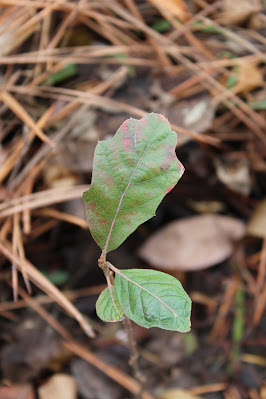We have four additions to the arboretum catalogue. All four plants are less than a year old. This past spring, they germinated in a large pot at a homeplace north of Shreveport. The pot was, at the time, meant for a satsuma tree. Oak acorns collected from the Centenary Campus were intentionally planted along with the satsuma, so that might explain the oak seedling that was found in the pot, but the other three seedlings volunteered and were allowed to grow in the pot over the course of the summer. On Wednesday, the four young trees were removed from the satsuma pot and transplanted into the arboretum.
 |
A black cherry (Prunus serotina) was planted at the top of a slope, in full sun, at the southwest corner of the arboretum. It measures 2 feet, 1½ inches.
|
 |
At the bottom of the same slope, in a sea of oak leaves, a leafless redbud (Cercis canadensis) was planted. The metal stakes marked with pink tape are absolutely necessary for protecting such an inconspicuous tree. It's the tallest individual planted, measuring 2 feet, 7½ inches.
|
 |
Taking a closer look at the redbud, we see the characteristic zig-zag stem.
|
 |
Across the sidewalk, closer to the Fitness Center, a red mulberry (Morus rubra) was planted. There are two red mulberry trees growing in full sun toward the top of the slope, so now we will see how the mulberry fares at the bottom, with more moisture.
|
 |
Our red mulberry is 1 foot tall.
|
 |
Lastly, we have a species of oak tree (Quercus sp.). This little tree, only 6 inches tall, was planted toward the top of the grassy slope on the north side of Cline Hall, not too far from the black cherry. We are hoping that this individual is a southern red oak (Quercus falcata). In the fall of 2022, acorns were collected from a mature southern red oak, growing on the Centenary Campus, near the intersection of Kings Highway and Centenary Boulevard. The acorns were planted in the satsuma pot, and in the spring, this oak sprouted, but its leaves do not resemble the leaves of the southern red oak from which acorns were collected. So, what are we to think?
|
 |
Now, would you say that this oak leaf resembles a duck foot print? If so, then there is no reason to doubt that this is a southern red oak. The experts at LSU explain that, "...leaves of seedlings and saplings typically lack lateral lobes, and have only a few shallow terminal lobes and blade shape that is broadest near the apex, resembling a duck foot print" (Louisiana Plant Identification and Interactive Virtual Tours). At minimum, we must conclude that leaves from a mature tree and leaves from a seedling differ in appearance, so we should be hopeful. But, for now, we will error on the side of caution and tag this individual as Quercus sp.
|






